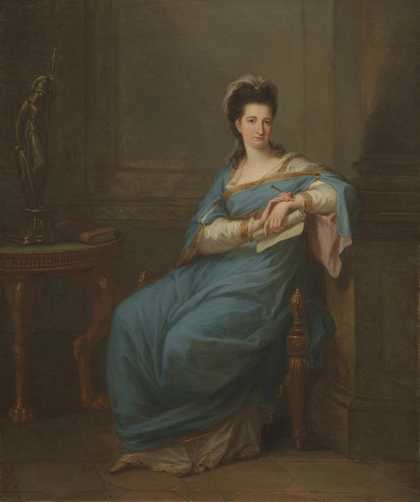
Angelica Kauffman
Portrait of a Lady (c.1775)
Tate
The subject of Angelica Kauffmann’s Portrait of a Lady wears a blue neoclassical robe with pink lining and gold trim. In the background is a statue of Minerva, goddess of wisdom. A book on the table next to her and writing materials suggest she is a writer, but we don’t know her name or anything else about her. Many people will likewise know little, if anything, about the artist who painted this picture - if I’m not mistaken, only one of a handful of female painters in the first two hundred years of art displayed in Tate Britain’s new hang. Yet in the sixteen years she lived in London, Kauffmann was one of the capital’s most sought-after portraitists, a founding member of the Royal Academy of Arts, as well as a distinguished history painter, whose death in Rome in 1807 was honoured by a magnificent funeral directed by Canova, during which, as at the burial of Raphael, two of her best pictures were carried in procession.
Kauffmann was a child prodigy who was producing commissioned portraits by the age of twelve. She had been trained by her painter father and worked as his assistant as they travelled through Switzerland, Austria and Italy before coming to England, giving her the opportunity, rare for a woman, to study classical and Renaissance works. A friend of Joshua Reynolds and other leading British artists, she signed the petition to the king for the establishment of the Royal Academy. In its first catalogue of 1769, she appears with RA after her name (an honour she shared with one other woman, Mary Moser). It was 167 years before another woman artist (Laura Knight) was elected to the RA.
Kauffmann and Moser were ‘notoriously marginalised’ in Johann Zoffany’s The Academicians of the Royal Academy 1772 depicting the founders surrounding a nude male model as though in a life drawing class. Since women were excluded from such training, they are represented in the form of portraits hanging on the wall. A later painting by Henry Singleton, The Royal Academicians in General Assembly 1795, shows them alongside the other academicians, but partially hidden behind the president’s chair with only their heads visible.
Kauffmann was an active member of the Blue Stockings Society, an influential group of educated, wealthy women who held regular cultural and social meetings. It seems likely to me that the subject of Portrait of a Lady would have also belonged to this group, and that a future art historian will be able to resurrect her name and career now that Tate Britain’s new hang has brought her, as well as the artist, back into public view.
